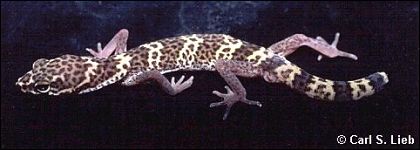
Geckos occur throughout temperate and tropical regions of the world, including our Chihuahuan Desert with its Banded Gecko. These small, insect-eating lizards are noteworthy for a number of reasons, especially for walking up vertical surfaces and even across ceilings! Proffered explanations included suction cups, a biological glue, or fine, crevice-grabbing hairs.
True understanding came only recently. Each gecko foot has roughly 500 thousand microscopically fine, hair-like setae, each of which has hundreds of small, spatula-like structures branching off. When objects get this minute, weak attraction between molecules, known as "van der Waals force", becomes significant. With the molecules from millions of setae exerting this attractive force, the gecko's foot is able to stick to just about any surface with enough strength to hold the animal upside down, though foot placement is critical for adhesion as well as for releasing the foot.
Knowledge of this mechanism has scientist and entrepreneurs wondering
if the same principle can be developed for human use. Who knows, we may soon be able to
hit the roof and stay there, just like a gecko. 
![]()
Contributor: Scott M. Cutler, Centennial Museum, University of Texas at El Paso.
Desert Diary is a joint production of the Centennial Museum and KTEP National Public Radio at the University of Texas at El Paso.
![]()

Texas Banded Lizard. Photography by Carl S. Lieb.
![]()
Autumn, K., Liang, Y.A.,; Hsieh, S.T., Zesch, W., Chan, W.P., Kenny, T.W., Fearing, R.. Full, R.J. 2000. Adhesive force of a single gecko foot-hair. Nature 405(8):681-684.
Autumn, K., Sitti, M., Liang, Y.A., Peattie, A.M., Hansen, W.R., Sponberg, S., Kenny, T.W., Fering, R., Israelachvili, J.N., Full, R.J. 2002. Evidence for vand der Waals adhesion in gecko setae. Proceedings of the National Academy of Sciences (early edition on website www.pnas.org/cgi/doi/10.1073/pnas.192252799)
![]()